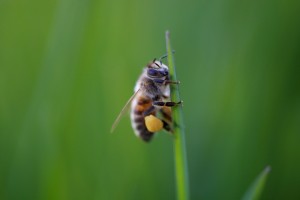28
Jul
Bee-Killing Pesticides Ubiquitous in Pollen Samples During Honey Bee Forage Season
(Beyond Pesticides, July 28, 2015) Data published from the Harvard School of Public Health reveals neonicotinoids (neonics), a class of chemicals implicated in the global decline of honey bees and other pollinators, in over 70% of both pollen and honey samples collected throughout the state of Massachusetts during months when bees are most actively foraging. The results of this study have grave implications for pollinator health, as even minute, near-infinitesimal doses of neonics can cause sublethal impacts that compromise the health of entire bee colonies.
 The Harvard study, led by Chensheng (Alex) Lu, PhD, and published in the Journal of Environmental Chemistry, took monthly honey and pollen samples from 62 volunteered bee hives between April and August 2013. The 219 pollen and 53 honey samples were then analyzed for the presence of eight neonic insecticides. Every month, in every location, researchers found neonics in the pollen and honey collected by bees. In total, 73% of pollen samples and 72% of honey samples contained at least one neonicotinoid at levels which could result in sublethal harm. While previous studies have tested the presence of neonics at a single point in time, this is the first study to show the long-term persistence of these chemicals throughout prime flowering season.
The Harvard study, led by Chensheng (Alex) Lu, PhD, and published in the Journal of Environmental Chemistry, took monthly honey and pollen samples from 62 volunteered bee hives between April and August 2013. The 219 pollen and 53 honey samples were then analyzed for the presence of eight neonic insecticides. Every month, in every location, researchers found neonics in the pollen and honey collected by bees. In total, 73% of pollen samples and 72% of honey samples contained at least one neonicotinoid at levels which could result in sublethal harm. While previous studies have tested the presence of neonics at a single point in time, this is the first study to show the long-term persistence of these chemicals throughout prime flowering season.
“Data from this study clearly demonstrated the ubiquity of neonicotinoids in pollen and honey samples that bees are exposed to during the seasons when they are actively foraging across Massachusetts. Levels of neonicotinoids that we found in this study fall into ranges that could lead to detrimental health effects in bees, including CCD,” said Dr. Lu. CCD, or Colony Collapse Disorder, is the name given to a phenomenon by which worker bees rapidly abandon their hives, leaving behind their queen, pollen, honey stores, and immature bees (brood).
Despite an ever-growing body of research linking neonics to pollinator declines, federal action in the U.S. remains slow or lackluster, while the European Union continues to enforce a moratorium on the use of these pesticides in agriculture. In the absence of federal and state action, numerous localities have stepped up to restrict the use of these chemicals, and encourage more widespread adoption of prudent measures to protect pollinators. Although addressing other stressors to pollinator populations, such as climate change, disease, and decreased habitat, are critically important, neonic insecticides continue to be the “low hanging fruit” which can be swiftly addressed by lawmakers and regulators.
In a phone interview with Beyond Pesticides, Dr. Lu explained that this study provides baseline data on the level and frequency of neonics in the state of Massachusetts. Were legislation passed to restrict the use of neonics, a follow-up study could be completed to discover whether such legislation decreased the incidence of these chemicals in pollen. Moreover, Massachusetts represents a state with relatively little agricultural production, compared to heavily farmed land in the Corn Belt, for instance. “I would expect this data [the incidence of neonics in pollen and honey] to be worse in states with a larger agricultural presence,” explained Dr. Lu.
Another noteworthy implication from that can be drawn from this research is that bees are not necessarily the only species exposed to neonic-contaminated pollen. Dr. Lu noted that some of the hives tested were within the city of Boston, and humans are likely to be exposed to the same contaminated pollen. Neonicotinoids are “readily available to uptake to humans because they are water soluble,” said Dr. Lu. This route of exposure essentially constitutes a non-target application of neonics, an area of contamination which federal regulators have not investigated. An analysis from the European Food Safety Authority in 2013 identified concerns with regard to the impact of neonics on childhood brain and nervous system development, underlining the importance of this exposure scenario.
For the health of humans and the pollinators we depend on for one in three bites of food, it is imperative that good policy be put in place to eliminate exposure to long lived, toxic neonicotinoid pesticides. To encourage a move away from these chemicals, support organic agriculture, which prohibits the use of toxic synthetic pesticides, and encourages farmers to create biodiverse agroecosystems to prevent pest problems before they occur. Also take action at the local, state and national level. Tell the Environmental Protection Agency to get serious about protecting bees from toxic pesticides, and take the BEE Protective Model Community Pollinator Resolution to your local elected officials. In order to fight back against the multinational chemical companies which produce these toxins, it is imperative for concerned residents to act.
Source: Harvard School of Public Health
All unattributed positions and opinions in this piece are those of Beyond Pesticides.










